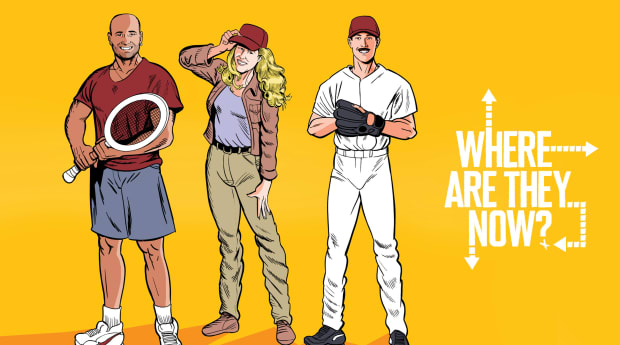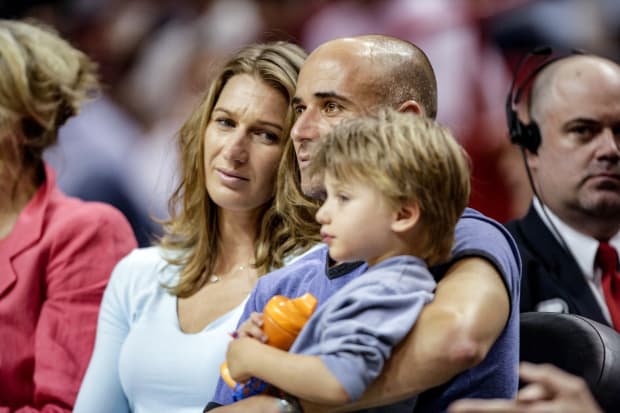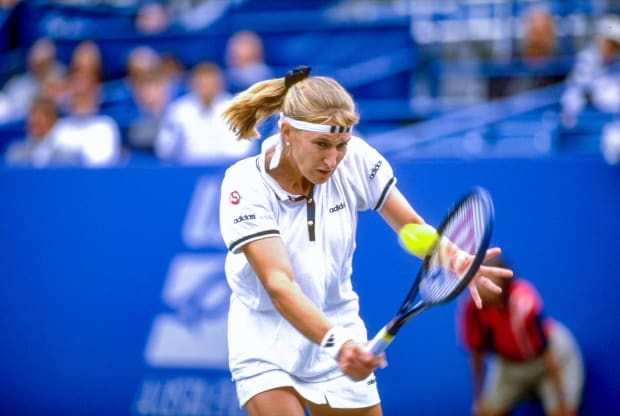When the tennis legend retired from competition more than 20 years ago, it was assumed that she would keep a low post-career profile. But even that might be understating her activity in the 21st century.
Each summer Sports Illustrated revisits, remembers and rethinks some of the biggest names and most important stories of our sporting past. Come back all week for more Where Are They Now? stories.
Tracy Austin did a double take. It was the spring of 2019, those halcyon pre-COVID-19 days, and Austin, once the No.1–ranked player on the WTA Tour, sat in the stands at the USC tennis facility. There to watch her son Brandon, then a junior, play a match, she glanced over and saw a familiar face, a genial, clean-shaven middle-aged man attired in a USC Trojans shirt. He was trailed by his blond wife—wearing more elegant attire and a tight smile. She, too, was a familiar face. “It was out of context, so it took a second,” says Austin. “But I’m like, ‘Wait, is that Andre and Steffi?”
It was. And Andre Agassi and Steffi Graf, arguably the most accomplished sports couple there ever was, had good reason to be on campus that day. Their son, Jaden, a crafty right-handed pitcher with Major League stuff, had recently committed to USC. The family had come to watch his future teammates play an afternoon game.
But the lure of the adjacent tennis facility proved irresistible to Jaden’s parents’ who had once ruled the sport, winning 30 majors singles titles between them (22–8 in Mom’s favor.) Agassi settled in and watched. “You know how Andre is and how his tennis brain works,” says Austin. “Immediately he started breaking down Brandon’s game.”

And his wife? “Well, she couldn’t have been nicer,” recalls Austin, whose career briefly overlapped with Graf’s. “But you know how Steffi is. I think she sort of quietly went out to the burger truck and picked up lunch for everyone.”
Graf and Agassi would make many more visits to Troy over the next few years. Jaden may have chosen a different hand-eye sport from his parents, but he, too, is an elite athlete. This spring, as a sophomore, he picked up a win against rival UCLA. He recently entered the transfer portal after the departure of his head coach; regardless, he will likely be a Major League draft pick.
That afternoon at the USC tennis facility, after Graf had departed, one woman who’d been seated nearby, turned to another.
“Do you know who that was you were talking to?” one woman asked.
“She said her son was playing baseball at USC and she had a daughter in high school,” the other explained. “And she was here with her husband. They live in Las Vegas.”
“That was Steffi Graf!” the friend practically hissed.
“No way! How was I supposed to know?”
In his excellent book The Sports Gene, David Epstein, once a journalist at Sports Illustrated, tells the story of Steffi Graf going to a German sports academy as a young girl. She was put through a battery of tests, assessed on various dimensions—competitive desire, running speed, ability to sustain concentration. Across the board, she placed first. As Wolfgang Schneider, a German sport psychologist, told Epstein, “We predicted from her lung capacity that she could have ended up the European champion in the 1,500 meters.”
Whether she chose the sport or it was foisted upon her, Graf devoted her vast talents and drive and lung capacity and competitive drive toward tennis. Her father, Peter, was a former soccer player and insurance salesman who took up tennis at age 27, relatively late in life for a new sport. But soon he was seduced, quitting his job to give lessons, operating the local tennis club in the Rhineland town of Bruhl. When his daughter was born in 1969, it took Peter scant time to proclaim her a future champion.

Illustration By Felipe Flores
Read More Where Are They Now? Stories
Sure enough. By age 3, Steffi, armed with a sawed-off wooden racket, was batting a ball back and forth over a couch in their living room. If Steffi could return Peter’s shots 25 times in a row, she was conferred a reward of ice cream and strawberries. “Most of the time, on the twenty-fifth ball, I would hit it too hard so she could not return it,” Peter Graf told the Los Angeles Times years later. “You cannot have ice cream all the time.”
At age 13, Steffi was winning West German junior championships open to players 18 and under. That same year, she received a professional ranking on the WTA’s computer. At the 1984 Olympics in Los Angeles, tennis was staged as a demonstration sport. Still, it drew a field of notable young pros. Having recently turned 15, Graf was the youngest player in the draw. She won gold.
In tennis—as in boxing and golf and, well, as in most sports—it’s the shoulders and arms and hands that get all the credit. But the lower extremities, literally, do much more of the lifting. And Steffi Graf’s legs propelled her all over the court with efficiency and speed and grace. Pushing off her legs while driving into her strokes, Graf generated insuperable power, the kind of pop that wouldn’t otherwise come from her slender frame. “She had the body of a gymnast,” says Martina Navratilova. “Then she hit the ball and, Whoa, how did that happen?”
Graf’s great stroke was her forehand, a fearsome blast that she often left the ground to smite. “Fraulein Forehand,” Bud Collins memorably nicknamed her. But Graf’s versatile backhand presented a sort of secret weapon hiding in plain sight. She either deployed a heavy one-handed drive, or a scythe-like slice that stayed low to the ground.
In addition to her athletic gifts, Graf’s arrival timing was excellent as well. She came along as Chris Evert and Navratilova—a tennis duopoly for more than a decade—were both north of age 30. And another ascending player from small-town Germany had recently broken through on the men’s side. And so Steffi could ride the German tennis boom created by Boris Becker, yet happily let him siphon national expectation and media coverage. If the paparazzi breathlessly followed the romantic exploits of “Boom-Boom Boris,” or reported on his every helicopter jaunt to Monaco, it meant that much less airtime and fewer column inches devoted to his female counterpart. (This pressure would exact a price on Becker; he is currently in a British prison after he was sentenced to two and a half years in prison for hiding assets during bankruptcy proceedings.)
With Peter watching, as ever, intently and intensively, Graf broke through at the 1987 French Open, outlasting Navratilova 6–4, 4–6, 8–6, and winning her first major title. “I used to be a little bit scared of playing Martina and Chris,” she said after the match in a rare burst of immodesty. “Now it’s their turn to be scared of me.” She was barely a week from turning 18. After that came the deluge.
In 1988, Graf didn’t merely win the Grand Slam—all four majors in a calendar year; a feat no player, male or female, has pulled off since—but turned in the “Golden Slam” by winning the Olympic singles event in Seoul, to boot. She won three majors the following year and suddenly had a haul of eight—more than what John McEnroe across his entire career—before she was old enough to drink (in the States, at least.) Her match record that year? 86–2.
And just as saying that Graf dominated the women’s game over the next decade almost manages to sell her short, referring to Graf as “shy” or “private,” as one inevitably does, would also be an act of definitional courtesy.
When Graf wasn’t playing, she covered her face with a veil of blond hair and avoided eye contact. By her own admission, she was deeply uncomfortable in press conferences, in front of cameras and at sponsor parties and other “events.” When forced to take questions, she gave polite and politic answers. The WTA assigned a media relations worker to encourage Graf, the tour’s brightest star, to be more front-facing. The more he asked, the more she declined.
It wasn’t that Graf lacked charm or warmth behind that on-court fire. And she was not, as the lazy narrative went, boring or incurious or devoted to tennis at the exclusion of all else. She read books. She went to Michael Jackson concerts and met him backstage. (“Meeting these people is interesting,” she said, “because they are never as you expect after reading about them.”) She stayed out late at discos. She once posed for the SI Swimsuit issue. She just kept a thick membrane between herself and most of the world. “You had to respect her for it,” Jim Fuhse, a longtime WTA staffer and friend of Graf, once told me. “She never, ever wavered from just wanting her tennis to speak for itself.”

Bill Frakes/Sports Illustrated
Graf did so by marrying her shotmaking—her “stroke production,” in tennis vernacular—and athleticism with an unshakeable, unbreakable will. She operated in two general modes: She would either destroy opponents, clinically and efficiently, not least at the 1988 French Open final she won 6–0, 6–0 in 32 minutes.
Or she would not be at her best, but then surge when the occasion called for it, as if simply telling herself I will not leave the court anything other than the winner. Consider: She won 107 titles in her career; she was the runner-up only 31 times. “So many times, you would think, ‘This is my day to beat Steffi.’ And then it wouldn’t be,” says Arantxa Sánchez Vicario, a chief Graf rival whose head-to-head record was 8–28.
Graf was still in her mid-20s, when she eclipsed Navratilova and Evert and won her 19th major, destined to be recalled as the GOAT. In all, she would spend a record 377 weeks‚ more than seven years—ranked No.1. Testament to her versatility, she would win each of the four majors at least four times, something no other player, male or female, has done. As Navratilova once memorably put it, Graf so often reduced the WTA Tour to “Steffi and the seven dwarfs.”
Her rare career dips, tellingly, had little to do with on-court resistance. Peter Graf was implicated in a series of scandals that included tax evasion, for which he eventually served 25 months in German prison. (Steffi claimed to have been unaware and was exonerated.) Her father’s contretemps exacted a price on her results, not least in 1990 when she won the first major and then, with Peter in the tabloids—lost the next three. “I could not fight as usual,” is how she put it to The New York Times in ’90.
In 1993, Graf’s ascending rival, Monica Seles, was stabbed on the court during a match. Not only did the crime occur at a German tournament, the culprit, a Graf fan, told authorities that he was acting to preserve his idol’s place atop the sport. (Seles had beaten Graf in four of their previous seven matches.) Multiple friends and former colleagues of Graf say that she never quite knew how to process this pivotal moment in tennis history. “I think she felt guilty benefiting in Monica’s [absence],” says Pam Shriver. “But I think she also resented that people held it against her.”
What would have happened to the Graf/Seles rivalry—and by extension, women’s tennis history—were it not for that horrific stabbing? It is the sport’s great, tragic counterfactual. Tennis fans and historians can—and do—debate how much was causation and how much was correlation. But here are the facts: In Seles’s absence, Graf won 10 of the next 13 majors she entered, cementing her spot as unrivaled and an all-time grande dame.
By the late 1990s, the path Graf had blazed was starting to pick up considerable foot traffic. A cohort of new players began to match her power. And unlike Graf, this new breed of players wanted the trappings of celebrity. The publicity. The red carpets and green rooms. The financial rewards of—dare we say it?—being a brand. The Williams sisters, Anna Kournikova, Martina Hingis … you could argue they were “the daughters of Steffi.” And yet they were many things that Graf wasn’t.
Graf seemed to warm to this generational challenge. At the 1999 French Open, having recovered from back trouble, she blazed through the draw. By the time Graf, quietly dignified as ever, was in position to upset the outspoken, tantrum-throwing teenager Hingis in the final, the entire stadium at Roland Garros was squarely in Graf’s corner, cheering her to victory, giving her a level of affection that never came when she was dominating. (The crowd in Paris returned the next day to cheer on the men’s sentimental champion-to-be, Andre Agassi.)
The following month at Wimbledon, Graf beat six players, including young Venus Williams, during a run to the final. There, she lost to Lindsay Davenport. Graf was 30; she was No. 3 in the rankings and more than holding her own against these extroverted younger opponents.
But then, in August 1999, Graf entered a run-of-the-mill WTA event outside San Diego. In the first round, she played Amy Frazier, a Michigander whom Graf had beaten in each of their previous five matches. They split the first two sets. Graf walked off the court in the third, citing a hamstring injury. She retired from the match and then, days later, from professional tennis. She would scarcely be seen in public again.

Manny Millan /Sports Illustrated
In addition to her retirement, Graf experienced another significant life event that summer of 1999. That was the season she began dating Andre Agassi. On its face it was the most unlikely of couplings. Though they were both tennis titans, less than a year apart in age, their paths didn’t cross much on the circuit. As Agassi tells it in his bracingly candid autobiography Open, he had long admired Graf from a distance, but when he once asked her to hang out, she didn’t bother responding.
Beyond that, the surface differences were as blazing as Agassi’s neon attire. He had the celebrity wattage of his hometown Las Vegas. Best known for the catchphrase, “Image is everything,” he was the most public of public figures. She was the introvert’s introvert. She would sooner eat Wimbledon grass than write a confessional memoir like Open.
Finally, in 1999, Agassi, fresh off his divorce from Brooke Shields, massed the courage to ask Graf to practice with him at a tournament. They discovered that their similarities were many, including their ambivalence about tennis and the complexities of having overbearing fathers. (The first time they met, Mike Agassi and Peter Graf reportedly came to blows arguing about tennis). And Agassi and Graf also discovered that their differences could be complementary.
Soon, to the shock of the republic of tennis, they were dating intensely. They married in 2001 and had two children, Jaden, now 20, and daughter Jaz, 18. After settling briefly outside of San Francisco, they moved to Las Vegas. Graf’s mother, Heidi, moved there as well. (Peter Graf died in ’13.) A sort of rebrand, Graf now goes by Stefanie, not Steffi.
And, in one of the great upsets in tennis (sports?) history, the Graf-Agassi marriage is … no big deal. Scarcely discussed. Almost taken for granted. Here is, by all rights, the ultimate sports power duo—with a body of collective work and celebrity halo to match pairing this side of Jay-Z and Beyoncé—and they cut the figure of, simply, a happy, suburban couple. No paparazzi. No gossip sites. No shows in development. No podcast. Never mind Image is everything. They encapsulate the phrase: You’re only as famous as you want to be.
By every account, theirs is a rich, fulfilling, durable marriage. But also a fiercely conventional marriage. “I’m telling you,” says a mutual friend, “You’ve never seen a more normal family. You would never know who they once were. It’s ‘Honey, we need light bulbs. I’ll pick some up on the way home.’ And they take pride in that.”
Tracy Austin uses an analogy from a sport other than tennis. “You know in cycling you have a front-runner, wearing the yellow jersey, getting attention and loving it? Then you have the Peleton, the people right behind, drafting? They’re perfect together because Andre is out there, he’s charismatic, he talks to people. Stefanie just very comfortable to be in the background and very happy there. It works great for them.”
When Graf retired, she told confidantes that she was through being a public figure. No more interviews. No more awkward sponsor grip-and-grins. No more contractually obligated appearances. She’s not the first retiring athlete to make this pronouncement. She’s among the few to stick so faithfully to her promise.
When a German tournament offered her a seven-figure appearance fee essentially to pose for photos and cut a ribbon, she declined. When producers inquire about documentaries, they’re politely turned away. @StefanieGraf has yet to tweet.
At Wimbledon in 2013, the WTA held a 40th-anniversary gala and invited all of the tour’s former No.1 players. From Billie Jean King to Navratilova to Evert to Austin to Jennifer Capriati, they came to this festival of sisterhood. Some were in their 80s and required walkers. Evonne Goolagong flew from Australia. She hit it off with Ana Ivanovic, a recent No. 1, almost 40 years her junior. Yet the woman who held the ranking longest was not in attendance.

Ethan Miller/Getty Images for Keep Memory Alive
Last fall, when Novak Djokovic was on the threshold—ultimately unsuccessful—of becoming the first player since 1988 to win the Grand Slam, the U.S. Open organizers hoped the last player to pull off the feat would be on hand. Steffi Graf declined the invitation.
Same for this article. Backstory: For years, I had tried to write this story with Graf’s participation. In 2016, when Agassi swung by the SI offices. We joked about the hardships I was having landing an audience with his wife. “Good luck with that,” he said, good-naturedly laughing at this quest.
Finally in 2018, through Longines, the French watch company Graf and Agassi represent, I had secured a 30-minute window to interview Graf at Roland Garros. A few days before the sit-down, a publicist informed me the time had been whittled to 15 minutes. O.K. A few days later, word came that “the team” would appreciate it if I could send questions in advance. Unable to accommodate that, I was told the interview was off. (For the story you are reading, in March, the manager Graf shares with Agassi graciously left word that Steffi “asked me to let you know she appreciates your catching up theme, but she is respectfully declining your offer.”)
To some in the tennis world, it’s a disappointment that such a towering champion has such a peripheral presence. “I want to choose my words carefully here,” says Shriver. “It’s too bad when players don’t give back to the sport what they got out of the sport.” Still, when Graf’s name comes up, the phrase in heaviest rotation goes like this: You have to respect her convictions …
Graf hasn’t been a total cipher in the tennis world. In 2004, she was inducted into the International Tennis Hall of Fame. She chose her husband to present her. In a speech worthy of your YouTube bandwidth, he began: “Words have yet to be invented that are large enough, colorful enough or true enough to express the heart and soul of this woman I love.”
Top players—often associated with Adidas—come to Las Vegas to train. Agassi’s longtime fitness guru and surrogate father, Gil Reyes, puts them through their paces. Agassi sometimes swings by for technical support. And a woman in her early 50s, limber as ever, is known to show up as a hitting partner, clubbing that forehand, showing poise and precision that have opponents only half-kiddingly daring her to make a comeback.
Rare as they are, Graf sightings are usually in conjunction with the Children for Tomorrow, a charity she has long quietly—of course quietly—supported. Per its website it addresses "the mental health of children and their families who have been affected by the atrocities of violence, war and persecution."
She is even more committed to two specific children: her own. When Jaden didn’t take to tennis, that was fine—a relief even—to his parents. When, at age 5, he fell hard for baseball, Steffi did her best to learn this foreign sport and its nuances. She’s a regular in the stands, full of positive encouragement, all strawberries and ice cream.
She tells friends that she often catches herself thinking how happily random life can be. She never thought she’d be here, this madchen from small-town Germany, behind the wheel of a hybrid car, tooling around Vegas, in her early 50s. Then again, she never thought she’d win 22 majors, marry another tennis player, or, for that matter, drive a car that doesn’t run solely on gasoline.
And when she pulls up to a traffic light or walks into a store and someone might occasionally recognize her as Steffi Graf the tennis champion. So be it. That’s the fame tax. More likely these days, they’ll identify her as Andre’s wife or Jaden and Jaz’s mom. And she likes that so much better.
Read More ‘Where Are They Now?’ Stories:
• Pete Sampras Is Doing Just Fine
• Katie Hamilton Will Speak For Herself, Thank You
• There Is Still Chlorine In Michael Phelps’s Soul